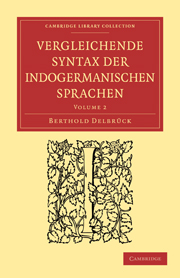Book contents
- Frontmatter
- Vorrede
- Inhaltsangabe
- Abkürzungen
- Kapitel XVI Tempora und Aktionen
- Kapitel XVII Die charakterisierten Präsensbildungen im Altindischen und Griechischen
- Kapitel XVIII Die aus einsilbigen Wurzeln gebildeten Formen (Präsentia und Aoriste)
- Kapitel XIX Die Formen aus Wurzeln auf o (mit o?)
- Kapitel XX Die Verba auf eiō
- Kapitel XXI Die indogermanischen Präsensaktionen im Germanischen und Slavischen
- Kapitel XXII Perfektivierung durch Verbindung mit Präpositionen
- Kapitel XXIII Das Perfektum
- Kapitel XXIV Die Aoriste
- Kapitel XXV Das Futurum
- Kapitel XXVI Mehrere Wurzeln zu einem Verbum vereinigt
- Kapitel XXVII Die Indikative im Arischen und Griechischen
- Kapitel XXVIII Die Indikative im Italischen, Germanischen, Litauischen, Slavisclien
- Kapitel XXIX Die Modi im Arischen und Griechischen
- Kapitel XXX Die Modi in den übrigen Sprachen
- Kapitel XXXI Die Genera Verbi im Arischen und Griechischen
- Kapitel XXXII Die Infinitive
- Kapitel XXXIII Partizipia und Verbaladjektiva
- Kapitel XXXIV Die Partikeln
- Index der Verbalformen
- Sach-Index
- Nachträge und Berichtigungen
Kapitel XXII - Perfektivierung durch Verbindung mit Präpositionen
Published online by Cambridge University Press: 05 August 2011
- Frontmatter
- Vorrede
- Inhaltsangabe
- Abkürzungen
- Kapitel XVI Tempora und Aktionen
- Kapitel XVII Die charakterisierten Präsensbildungen im Altindischen und Griechischen
- Kapitel XVIII Die aus einsilbigen Wurzeln gebildeten Formen (Präsentia und Aoriste)
- Kapitel XIX Die Formen aus Wurzeln auf o (mit o?)
- Kapitel XX Die Verba auf eiō
- Kapitel XXI Die indogermanischen Präsensaktionen im Germanischen und Slavischen
- Kapitel XXII Perfektivierung durch Verbindung mit Präpositionen
- Kapitel XXIII Das Perfektum
- Kapitel XXIV Die Aoriste
- Kapitel XXV Das Futurum
- Kapitel XXVI Mehrere Wurzeln zu einem Verbum vereinigt
- Kapitel XXVII Die Indikative im Arischen und Griechischen
- Kapitel XXVIII Die Indikative im Italischen, Germanischen, Litauischen, Slavisclien
- Kapitel XXIX Die Modi im Arischen und Griechischen
- Kapitel XXX Die Modi in den übrigen Sprachen
- Kapitel XXXI Die Genera Verbi im Arischen und Griechischen
- Kapitel XXXII Die Infinitive
- Kapitel XXXIII Partizipia und Verbaladjektiva
- Kapitel XXXIV Die Partikeln
- Index der Verbalformen
- Sach-Index
- Nachträge und Berichtigungen
Summary
Allgemeines
Begrenzung des Begriffes perfektiv
Der Ausdruck ‘perfektiv’ ist seit lange in der slavischen Grammatik heimisch, wo man eine Verbalform dann perfektiv nennt, wenn sie ausser der Verbalhandlung zugleich den Nebenbegriff der Vollendung enthält (so definiert bei Leskien Handbuch, 149). Man wendet aber diesen Ausdruck nicht bloss, wie es nach der Überschrift dieses Kapitels scheinen könnte, auf die zusammengesetzten, sondern auch auf die einfachen Verba an, z. B. auf darrǐ ‘ich werde hingeben’. Ich muss aber gestehen, dass ich mich dieser Ausdehnung des Begriffs perfektiv nicht anschliessen kann. Denn bei einer Form wie damǐ steht es doch nicht so, dass die Wurzel den allgemeinen, unbegrenzten Begriff des Gebens enthält, zu welchem in dei slavischen Fonn der Nebenbegrirff der Vollendung hinzutritt, sondern (wenn anders dasjenige einigen Grund hat, was ich in den früheren Kapiteln dieser Schrift ausgeführt habe) die Wurzel enthält von vornherein die einfache Anschauung des Hingebens, und diese Anschauung setzt sich in der slavischen Form fort, die deshalb rich tiger punktuell als perfektiv genannt wird. Ich glaube natürlich nicht, dass es mir gelingen könnte, die Slavisten zu einer änderung ihrer Terminologie zu veranlassen, aber in einer Schrift, in welcher das Hauptgewicht auf die richtige Erfassung der geschichtlichen Zusammenhänge gelegt wird, mag es erlaubt sein, in diesem Punkte von der gebräuchlichen Bezeichnungsart abzuweichen.
- Type
- Chapter
- Information
- Vergleichende Syntax der indogermanischen Sprachen , pp. 146 - 170Publisher: Cambridge University PressPrint publication year: 2010First published in: 1897



